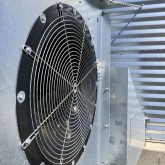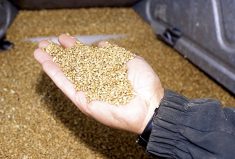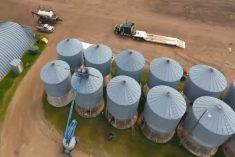It has been a difficult and stuttering harvest this year with short periods of combining between showers and cool temperatures.
“You might breathe a sigh of relief when harvesting is complete, but it really isn’t done until the grain ends up at the buyer’s and is paid for,” said crop specialist Harry Brook. “Maintain vigilance when the crop is in the bin. A lot of this year’s crop is not totally dry and will need aeration or drying before selling.”
If grain is placed in the bin damp or even wet, safe storage time is limited before it degrades or attracts grain insects.
Read Also

Farming Smarter receives financial boost from Alberta government for potato research
Farming Smarter near Lethbridge got a boost to its research equipment, thanks to the Alberta government’s increase in funding for research associations.
Aeration is best used for reducing temperatures rather than drying, he said.
“However, if you are trying to use aeration and supplemental heat, be aware the air requirements to make that work are much higher than for merely reducing the crop temperature.”
Aeration for purposes of cooling only requires an airflow of 0.1 to 0.25 cubic feet per minute per bushel (cfm/bu.).
“If you are trying to use supplemental heat, you need to up the airflow to 0.25 to 0.50 cubic feet per minute per bushel,” said Brook. “Dryeration — using aeration for drying — takes a long time, taking 200 to 400 hours to drop moisture one to three per cent.
“Grain drying uses the highest airflow. To dry up to four to five per cent moisture from the crop, you need fans to push 0.75 to 1.0 cubic feet per minute per bushel to dry the grain. This can take up to 750 hours.”
Other factors to consider include:
- Once the drying front starts moving, it should not be stopped until it passes through the entire bin.
- The bottom of the bin will be overdry when the top is dry. “Moving the grain will help equalize the moisture, but you don’t want to overdry grain as that could result in income lost that could be paid for by the grain buyer.”
- Beware of moisture circulation in the bin. Cold air outside will cool the grain against the bin sides and moisture will move down the outsides of the bin then come up the middle. “If there is any place for the moisture to accumulate, it will be just below the top and middle of the bin.”
- Green seed or immature seed in the bin may also contain more moisture and add to the problem. “This is why it is imperative when harvesting immature grain to keep it cool. If moisture does move and centralize in the bin, it starts to heat and that attracts grain beetles.”
“Cool, wet harvesting conditions are potential ingredients to cause storage problems,” Brook added.
“You have spent a lot of money and time getting the harvest in the bin. Take the time to monitor the stored grain condition and keep the bins cool. Don’t get an unpleasant surprise when selling the grain with discounts for heated grain or insect problems.”















